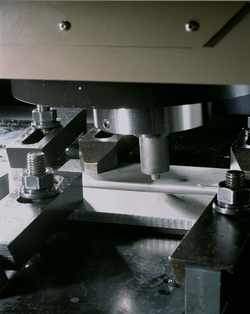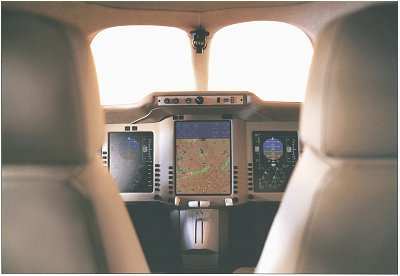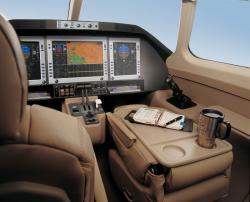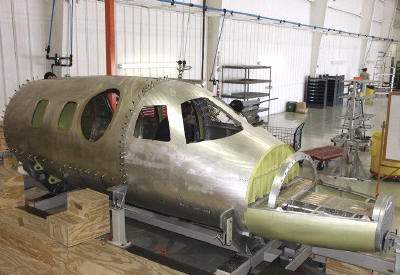At Saturday's public rollout of the new Eclipse jet (see
related story), Eclipse boss Vern Raburn showed the world just
what's been taking all his time lately.

As he told us earlier, the Eclipse is really "all new." Sure,
it's a twin-engine jet airplane, made of metal. That kind of
thing's been done before; it doesn't take long to come up with
example after example. There are three things that make the Eclipse
"new," though.
Engines
 One
thing Raburn says that makes the Eclipse "all new" is the new
engine, the Williams EJ-22. It's been flown in test, and Raburn
himself says it isn't 'perfect' yet -- but hey! It's been flown
once. By the time it's certified and flying regularly, it will be
every bit ready, delivering unprecedented thrust/pound of
fuel/hour, and propelling the Eclipse quite well. Its development
is on-time and on-schedule; and there's no reason to think it won't
stay that way.
One
thing Raburn says that makes the Eclipse "all new" is the new
engine, the Williams EJ-22. It's been flown in test, and Raburn
himself says it isn't 'perfect' yet -- but hey! It's been flown
once. By the time it's certified and flying regularly, it will be
every bit ready, delivering unprecedented thrust/pound of
fuel/hour, and propelling the Eclipse quite well. Its development
is on-time and on-schedule; and there's no reason to think it won't
stay that way.
Manufacturing
Really "new" is the concept of manufacturing. Vern Raburn said,
"There are some technologies that we're exploiting really well.
[Metal] airplanes are maybe 70%, 80% or even more, made from
stampings, pressings, bent pieces of aluminum. The Eclipse airframe
is mostly machined. That gives us lighter weight, often stronger
parts, a lower parts count -- and the fit is within .003 of an
inch."
 Manufacturing of other precision assemblies has
been done that way for years; the airplane industry, though, due to
the innate traditional designs and a high degree of conservatism in
the industry, hasn't moved, until now. "Most of our parts are
machined on 5-axis machinery. We even get lower scrap. Lots of
parts are pilot-drilled for easier location in assembly. It's to a
certain extent, self-jigging -- our assembly time is 'way low."
Raburn extolled that kind of manufacturing, for volume especially,
and compared it to the composite aircraft. "With a composite plane,
in an assembly shop, you see all kinds of grinders, etc. -- that's
to make it fit together. Ours: we just kind of put the parts next
to each other, and they fit, and we have an airplane."
Manufacturing of other precision assemblies has
been done that way for years; the airplane industry, though, due to
the innate traditional designs and a high degree of conservatism in
the industry, hasn't moved, until now. "Most of our parts are
machined on 5-axis machinery. We even get lower scrap. Lots of
parts are pilot-drilled for easier location in assembly. It's to a
certain extent, self-jigging -- our assembly time is 'way low."
Raburn extolled that kind of manufacturing, for volume especially,
and compared it to the composite aircraft. "With a composite plane,
in an assembly shop, you see all kinds of grinders, etc. -- that's
to make it fit together. Ours: we just kind of put the parts next
to each other, and they fit, and we have an airplane."
Back to contrasting with other metal aircraft: "We have changed
the assembly so radically -- we don't issue our assemblers rubber
mallets and shim stock," he laughed. Simply put, "We have changed
the way airplanes are made."
Electronics
"We weren't about to build an airplane, especially from an
'electronics platform' point of view, the way some other
competitors have," Raburn began. "This is the first truly
all-electric GA airplane." Wha? "It's all
electric," he said. "It's all integrated.
Everything on this airplane, from nav lights to engine, to air
conditioning -- is run through two central computers, that are
aware of every condition on the aircraft. No mechanical
circuit-breakers. There's just four current-carrying switches on
the whole airplane." Unbelievable. Oops: "There's one circuit [with
a load-carrying switch] for the cabin light; and there's two
mechanical breakers, on the battery bus."

"We run four FADECs (two engines, with two redundant systems
each)."
If there's trouble, the electronics take over. "The MFD shows
each breaker that's open, the fault condition, and a checklist for
that particular circuit." Right there; right now. Vern sees a lot
of advantage to the glass in the cockpit, and the electronic
approach, in general: "This will increase reliability, ease of use,
decrease weight and cost, and increase safety," he says.
 "It's
all-electronic. Even, take the Fowler flaps -- ordinarily you'd
have an interconnected mechanical system." Raburn then spoke of
how, since the flaps extend along a good portion of the wing, the
flap actuators themselves move different amounts at different
stations, to keep everything straight, yet accommodate the taper of
the wing and airfoil. Mechanically, it's a lot easier on a
constant-chord wing, which the Eclipse isn't. "We have an
electronic system, that talks among the actuators -- they're
self-rigging; if one actuator doesn't talk to the others for a
moment, the other actuators shut down, until the trouble is found."
Each actuator is independently controlled, getting its commands
from one of the two central computers, as each actuator is queried
some 400 times a second. The computer makes sure all the actuators
are working in harmony. If one isn't, the pilot is notified, with
helpful suggestions.
"It's
all-electronic. Even, take the Fowler flaps -- ordinarily you'd
have an interconnected mechanical system." Raburn then spoke of
how, since the flaps extend along a good portion of the wing, the
flap actuators themselves move different amounts at different
stations, to keep everything straight, yet accommodate the taper of
the wing and airfoil. Mechanically, it's a lot easier on a
constant-chord wing, which the Eclipse isn't. "We have an
electronic system, that talks among the actuators -- they're
self-rigging; if one actuator doesn't talk to the others for a
moment, the other actuators shut down, until the trouble is found."
Each actuator is independently controlled, getting its commands
from one of the two central computers, as each actuator is queried
some 400 times a second. The computer makes sure all the actuators
are working in harmony. If one isn't, the pilot is notified, with
helpful suggestions.
It's called, 'Avio'
Avio(TM) takes advantage of today's digital electronics
technology to place "intelligence" throughout the airplane, which
is controlled by redundant central aircraft computers that monitor
and control the aircraft's systems. Avio replaces the dozens of
expensive instruments and gauges typically found in today's
airplanes with a streamlined glass cockpit that integrates multiple
functions and is tied into the electronics systems throughout the
aircraft.
"Avio is one of the major innovations that make the low purchase
price of the Eclipse 500 possible," said Vern Raburn, president and
CEO of Eclipse Aviation. "Today's announcement just scratches the
surface of what Avio will deliver. Avio is pervasive in the Eclipse
500 and will benefit many aspects of aircraft operation. We will
unfold the complete story over the months to come."
The Eclipse is also, Raburn is pretty sure, the "first airplane
under $35 million with a full auto-throttle system." He talks
momentarily of the (larger-airplane) competition: It's a
$250,000 option in a Falcon, or a G-IV. It's standard on the
Eclipse." Raburn, who still manages to fly about 400 hours a year,
says that, "on a non-precision approach, the pilot has to keep the
speed stabilized, keep the airplane right side up, and keep it
pointed in the right direction. The auto-throttle is safety: the
computer keeps the speed, and therefore the sink rate, right; the
pilot keeps the top side up." In what is designed to be flown as a
one-pilot airplane, that's a lot of help.

Still, Raburn said, "This is not a fly-by-wire airplane; it's
push-pull cables and pushrods." With all the electronics, why make
it the "old fashioned" way? Because that way makes the most sense.
The Eclipse is a small airplane, compared to the fly-by-wire
machines we may reference in our minds, things like A340s, or even
F-16s. Vern said, "Our cables run maybe 25 feet, and we don't need
boosted controls; it's much easier to simply apply flight-envelope
protection (a la Airbus, or even , to some extent, the F-16). We
decided not to go fly-by-wire." Everything else is electronic,
though: the gear, the flaps, the air conditioning.
Almost everything. The brakes are positively stone-aged, in
comparison to the rest of the airplane. Why? There's no reason to
complicate things, just to say they're "modern." The brakes, Vern
says, "are just like on a Bonanza. No boost, no anti-skid." Why?
"You don't need it. This jet lands," he reminded
us, "just four knots faster than a Bonanza."
[ANN Thanks News-Spy Stan Cooper for the GREAT
roll-out photo!]
 ANN's Daily Aero-Term (04.20.24): Light Gun
ANN's Daily Aero-Term (04.20.24): Light Gun Aero-News: Quote of the Day (04.20.24)
Aero-News: Quote of the Day (04.20.24) ANN's Daily Aero-Linx (04.21.24)
ANN's Daily Aero-Linx (04.21.24) Aero-News: Quote of the Day (04.21.24)
Aero-News: Quote of the Day (04.21.24) ANN's Daily Aero-Term (04.21.24): Aircraft Conflict
ANN's Daily Aero-Term (04.21.24): Aircraft Conflict








